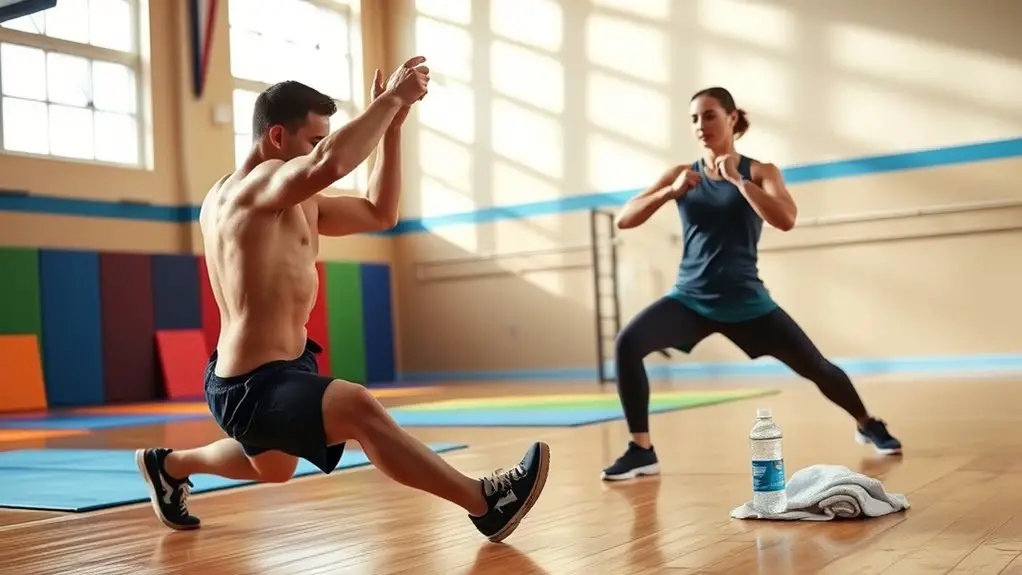To prevent hamstring injuries, you need an effective warm-up routine. Incorporate dynamic stretches like leg swings, walking toe touches, high knees, and butt kicks. These movements improve flexibility and activate your hamstrings, preparing them for activity. Start with light jogging and gradually increase intensity to elevate your heart rate. Remember, a proper warm-up not only reduces injury risk but enhances performance too. There's much more you can do to optimize your routine.
Understanding Hamstring Injuries
When you think about hamstring injuries, it's essential to understand what they are and why they happen. Hamstring injuries involve the muscles at the back of your thigh, and they can occur when those muscles are overstretched or overworked. This can happen during explosive movements like sprinting or jumping, where your legs are pushed to their limits. If you've ever felt a sudden sharp pain in the back of your leg, you know how debilitating it can be.
These injuries can range from mild strains to severe tears, impacting your freedom to move and engage in activities you love. Factors like poor flexibility, muscle imbalances, and lack of conditioning can increase your risk. By understanding these aspects, you can make informed choices to protect yourself, ensuring you stay active and enjoy the freedom of movement without the worry of injury. Strong and flexible hamstrings contribute to fluid and powerful movement, further emphasizing the need for proper care and conditioning.
Importance of a Proper Warm-Up
A proper warm-up is essential for preventing hamstring injuries, especially since it prepares your muscles for the demands of physical activity. When you take the time to warm up, you're not just going through the motions; you're activating your body and getting your blood flowing. This increased circulation delivers oxygen to your muscles, helping them perform better and reducing the risk of strains or tears.
Moreover, warming up enhances your range of motion, making it easier for you to move freely during your workout or sport. It also helps mentally prepare you, allowing you to focus and get in the zone. Skipping this crucial step may lead to discomfort or injury, which can limit your ability to enjoy your activities. Additionally, incorporating dynamic stretching into your warm-up routine optimizes muscle readiness and performance. So, embrace the freedom that comes from a proper warm-up and give your body the best chance to perform at its peak while staying injury-free.
Dynamic Stretching for Hamstring Activation
Dynamic stretching plays an important role in activating your hamstrings before any workout. By incorporating effective dynamic stretches, you can improve flexibility and reduce the risk of injury. Timing your warm-up is essential, so don't skip this key step in your routine.
Importance of Dynamic Stretching
If you want to effectively activate your hamstrings and reduce the risk of injury, incorporating dynamic stretching into your warm-up routine is crucial. Unlike static stretches, dynamic stretches involve movement, which helps prepare your muscles for the activity ahead. By engaging in dynamic stretching, you increase blood flow, improve flexibility, and enhance muscle control—all essential for peak performance. It's not just about flexibility; it's about getting your body ready to move freely and efficiently. This activation process primes your hamstrings, making them more responsive during your workout or sporting activity. Remember, the goal is to feel liberated in your movements, and dynamic stretching is a powerful tool to help you achieve that freedom while minimizing injury risks.
Effective Dynamic Stretches
To effectively activate your hamstrings, incorporating specific dynamic stretches into your warm-up can make a significant difference. These stretches not only prepare your muscles but also enhance your freedom of movement. Here are some effective dynamic stretches to take into account:
- Leg Swings: Swing your legs forward and backward, feeling the stretch in your hamstrings while maintaining balance.
- Walking Toe Touches: Step forward, reaching down to touch your toes, and feel the lengthening of your hamstrings with each step.
- High Knees: Jog in place, lifting your knees high to engage your hamstrings and get your heart pumping.
- Butt Kicks: Run in place, kicking your heels towards your glutes to activate those hamstrings and boost circulation.
Incorporate these into your routine, and you'll feel the difference!
Timing for Warm-Up
Incorporating effective dynamic stretches is just the start; timing plays a crucial role in maximizing their benefits for hamstring activation. You'll want to warm up about 10 to 15 minutes before your workout. This window allows your body to gradually increase its core temperature and blood flow to your hamstrings, making them more pliable. Start with lighter movements, like leg swings or high knees, to awaken those muscles. As you progress, you can ramp up the intensity and range of motion. Remember, it's not just about stretching; it's about getting your body ready to move freely and with confidence. Prioritize this timing, and you'll greatly reduce your risk of injury while enjoying your activities.
Hamstring-Specific Strengthening Exercises
Strengthening your hamstrings is essential for injury prevention and overall athletic performance. When your hamstrings are strong, they can better support your movements, giving you the freedom to run, jump, and pivot without fear of injury. Here are some effective hamstring-specific strengthening exercises you can add to your routine:
- Deadlifts: Feel the power as you lift heavy, engaging every muscle fiber.
- Nordic curls: Experience the burn while building incredible strength.
- Single-leg bridges: Activate your core and hamstrings, enhancing stability.
- Hamstring sliders: Glide smoothly, challenging your muscles through controlled motion.
Incorporating these exercises into your routine not only fortifies your hamstrings but also boosts your overall athletic performance. Additionally, prioritizing proper warm-ups is crucial to prepare your muscles and prevent injuries. Embrace the journey to stronger legs and enjoy the freedom that comes with injury-free movement!
Incorporating Mobility Drills
While strengthening your hamstrings is essential, incorporating mobility drills can greatly enhance your overall flexibility and range of motion. These drills help loosen tight muscles and improve your body's ability to move freely. Consider adding dynamic stretches like leg swings and walking lunges to your warm-up routine. They'll not only prepare your hamstrings but also engage your hips and lower back, promoting a holistic approach to mobility.
Don't forget to include movements like inchworms and hip circles, which encourage fluidity in your joints. By integrating these drills, you create an environment where your body feels more liberated and responsive. This freedom of movement can be crucial in preventing injuries during your activities. Additionally, incorporating mobility training helps maintain joint health and reduces the risk of strains and sprains. So, embrace mobility drills as a key component of your warm-up, allowing you to perform with ease and confidence. Your hamstrings will thank you, paving the way for a more enjoyable experience in all your physical pursuits.
Creating a Customized Warm-Up Routine
As you prepare for physical activity, creating a customized warm-up routine tailored to your specific needs can make all the difference. This routine should energize you and get your body ready for action. Here are four key components to take into account:
- Dynamic stretches: Think leg swings and walking lunges that get your muscles moving.
- Mobility exercises: Incorporate hip circles and ankle rolls to enhance joint flexibility.
- Sport-specific movements: Mimic the actions you'll perform, like light jogging or quick lateral steps.
- Gradual intensity: Start slow, then increase the pace to elevate your heart rate and blood flow. Additionally, remember that dynamic stretching is essential for activating muscles and preparing the body for action.
Frequently Asked Questions
How Long Should a Warm-Up Session Last?
You're about to plunge into a workout, feeling that rush of energy. A warm-up session should last around 10 to 15 minutes; it'll help you move freely, keeping injuries at bay and enhancing performance.
Can I Warm up Without Equipment?
Absolutely, you can warm up without equipment! Just focus on dynamic stretches and bodyweight movements like leg swings and lunges. It's all about getting your muscles ready and increasing blood flow. Enjoy the freedom!
What Should I Do if I Feel Pain During Warm-Up?
If you feel pain during warm-up, it's not your body's way of auditioning for a drama. Stop, assess, and maybe consult a professional. Your freedom to move shouldn't come with a side of injury!
Are There Specific Warm-Ups for Different Sports?
Each sport has unique movements, so specific warm-ups help prepare your body. Whether it's dynamic stretches for running or agility drills for soccer, tailoring your routine can enhance performance and reduce injury risk.
How Often Should I Change My Warm-Up Routine?
Changing your warm-up routine every four to six weeks can boost performance, as studies show varied exercises improve engagement by 20%. Embrace this freedom; keeping your body guessing helps prevent stagnation and enhances your overall experience.




